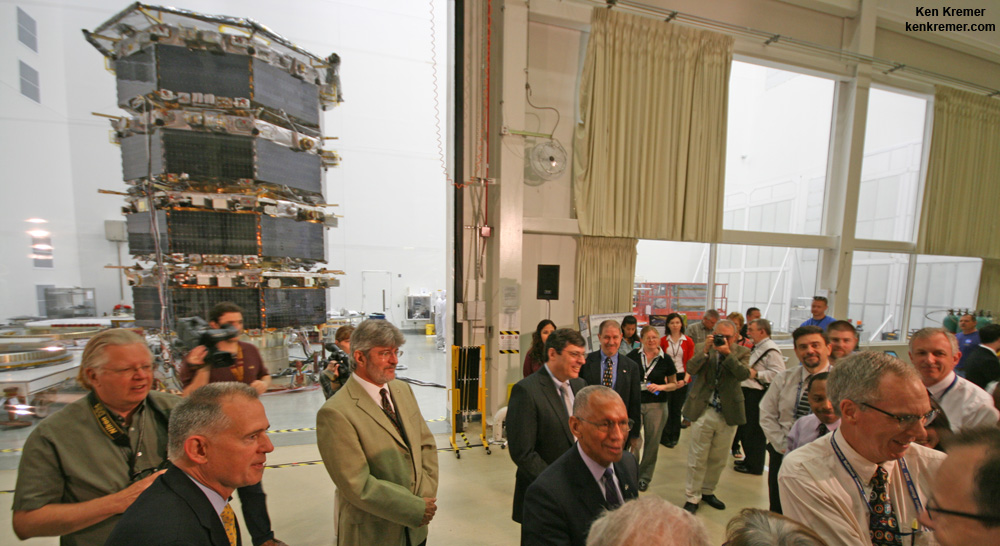
NASA GODDARD SPACE FLIGHT CENTER, MD — An armada of four virtually identical spacecraft comprising NASA’s groundbreaking Magnetospheric Multiscale (MMS) mission will soon fly through Earth’s magnetic reconnection events to capture the first three-dimensional maps of this little understood process that releases vast amounts of energy into the magnetosphere that protects Earth.
NASA Administrator Charles Bolden made a special visit to inspect the observatory quartet in their rarely mated and fully stacked launch configuration inside the Goddard cleanroom, along with NASA Science Chief John Grunsfeld and Goddard Center Director Chris Scolese on May 12. And AmericaSpace was on site for a firsthand look and detailed briefing from NASA’s leaders and the mission team at the Goddard cleanroom about the mission’s science goals.
“MMS will help us study the phenomena known as magnetic reconnection and help us understand how energy from the sun – magnetic and otherwise – affects our own life here on Earth,” NASA Administrator Bolden told AmericaSpace in an exclusive one-on-one interview at the MMS cleanroom.
“I’m visiting with the MMS team today to find out the status of this mission scheduled to fly early in 2015.”
This was the last time that the 20-foot-tall MMS observatory quartet would be stacked until they are remated for final checkout at NASA’s Kennedy Space Center in Florida.
They were piled in the rarely seen launch arrangement known affectionately as the “IHOP configuration,” since they resemble a stack of delicious pancakes loaded with scrumptious toppings—in this case being two dozen state-of-the-art science instruments popping out all around.
The four spacecraft are still undergoing critical testing by technicians and were completely destacked less than a day later.
MMS will soar to orbit in March 2015 aboard a United Launch Alliance Atlas V booster from Launch Complex 41 at Cape Canaveral Air Force Station, Fla.
“MMS will study what effects the magnetic reconnection process … and how the magnetosphere protects Earth,” Bolden explained to me. “It’s one of many projects here at Goddard.”

Magnetic reconnection is the process whereby magnetic fields around Earth connect and disconnect while explosively releasing vast amounts of energy. It occurs throughout our universe but is best studied “in situ” in Earth’s magnetosphere.
“MMS is a fundamental heliophysics science mission,” said Craig Tooley, MMS project manager at Goddard in an exclusive interview beside the spacecraft in the cleanroom.
“Unlike Hubble that uses remote sensing, MMS is like a flying laboratory ‘in situ’ that will capture events that are the major energy transfer from the sun’s magnetic field into our Earth’s space weather environment and magnetosphere.”
“These are called magnetic reconnection events that pump enormous amounts of energy into the plasma and the fields around Earth. It’s one of the main drivers of space weather and a fundamental physical process that is not very well understood,” Tooley said.
So the spacecraft will use the Earth itself as a laboratory to unlock the mysteries of magnetic reconnection—the primary process that transfers energy from the solar wind into Earth’s magnetosphere and is responsible for geomagnetic storms.

They are equipped with 25 science sensors to study the microphysics of three fundamental plasma processes: magnetic reconnection, energetic particle acceleration, and turbulence.
“To understand the fundamental physics, they will fly in a pyramid-like formation and capture the magnetic reconnection events in 3-D by flying through them as they happen – that’s why we have 4 spacecraft,” Tooley explained.
“Initially they will be spaced apart by about 10 to 30 kilometers while they fly in a tetrahedron formation and scan with their booms spread out – depending on what the scientists says is the optimal configuration.”
“They fly in a highly elliptical orbit between about 7,000 and 75,000 kilometers altitude during the first half of the mission. Eventually the orbit will be extended out to about 150,000 kilometers.”
Magnetic reconnection is believed to help trigger the spectacular aurora known as the Northern or Southern lights on the night side of Earth.
It can link the Sun’s magnetic field lines to Earth’s magnetic field lines on the Sun side of Earth, allowing material and energy from the Sun to funnel into Earth’s magnetic environment.

“The primary mission will last two years,” Tooley told me.
“Each spacecraft carries about 400 kilograms of fuel. There is a possibility to extend the mission by about a year based on fuel consumption.”
“The spacecraft were built in-house here at Goddard and just completed vibration testing.”
Vibration testing is a major milestone and is conducted to ensure the spacecraft can withstand the most extreme vibration and dynamic loads they will experience, which occurs during liftoff inside the fairing of the Atlas V booster.
Later this year, the spacecraft will be shipped in pairs of two down to KSC for final reassembly and prelaunch testing before loading inside the Atlas V payload fairing.
MMS is a Solar Terrestrial Probes (STP) mission within NASA’s Heliophysics Division funded by the Science Mission Directorate (SMD).
Want to keep up-to-date with all things space? Be sure to “Like” AmericaSpace on Facebook and follow us on Twitter: @AmericaSpace






This is fascinating! I am grateful to the scientists who are studying the Magnetospheric Multiscale. “Magnetic reconnection is believed to help trigger the spectacular aurora known as the Northern or Southern lights on the night side of Earth.”